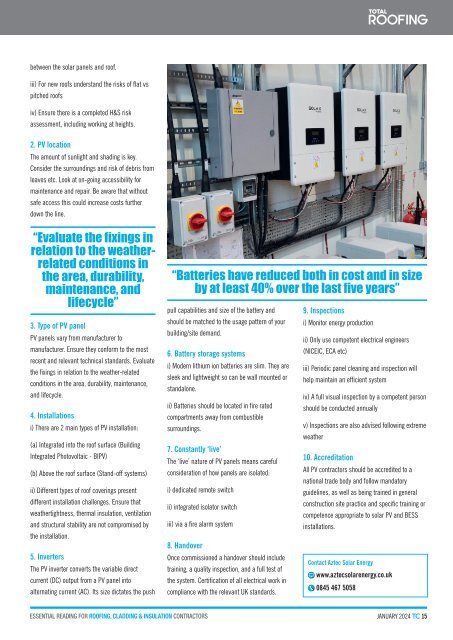January 2024
You also want an ePaper? Increase the reach of your titles
YUMPU automatically turns print PDFs into web optimized ePapers that Google loves.
etween the solar panels and roof.<br />
iii) For new roofs understand the risks of flat vs<br />
pitched roofs<br />
iv) Ensure there is a completed H&S risk<br />
assessment, including working at heights.<br />
2. PV location<br />
The amount of sunlight and shading is key.<br />
Consider the surroundings and risk of debris from<br />
leaves etc. Look at on-going accessibility for<br />
maintenance and repair. Be aware that without<br />
safe access this could increase costs further<br />
down the line.<br />
“Evaluate the fixings in<br />
relation to the weatherrelated<br />
conditions in<br />
the area, durability,<br />
maintenance, and<br />
lifecycle”<br />
3. Type of PV panel<br />
PV panels vary from manufacturer to<br />
manufacturer. Ensure they conform to the most<br />
recent and relevant technical standards. Evaluate<br />
the fixings in relation to the weather-related<br />
conditions in the area, durability, maintenance,<br />
and lifecycle.<br />
4. Installations<br />
i) There are 2 main types of PV installation:<br />
(a) Integrated into the roof surface (Building<br />
Integrated Photovoltaic - BIPV)<br />
(b) Above the roof surface (Stand-off systems)<br />
ii) Different types of roof coverings present<br />
different installation challenges. Ensure that<br />
weathertightness, thermal insulation, ventilation<br />
and structural stability are not compromised by<br />
the installation.<br />
5. Inverters<br />
The PV inverter converts the variable direct<br />
current (DC) output from a PV panel into<br />
alternating current (AC). Its size dictates the push<br />
“Batteries have reduced both in cost and in size<br />
by at least 40% over the last five years”<br />
pull capabilities and size of the battery and<br />
should be matched to the usage pattern of your<br />
building/site demand.<br />
6. Battery storage systems<br />
i) Modern lithium ion batteries are slim. They are<br />
sleek and lightweight so can be wall mounted or<br />
standalone.<br />
ii) Batteries should be located in fire rated<br />
compartments away from combustible<br />
surroundings.<br />
7. Constantly ‘live’<br />
The ‘live’ nature of PV panels means careful<br />
consideration of how panels are isolated:<br />
i) dedicated remote switch<br />
ii) integrated isolator switch<br />
iii) via a fire alarm system<br />
8. Handover<br />
Once commissioned a handover should include<br />
training, a quality inspection, and a full test of<br />
the system. Certification of all electrical work in<br />
compliance with the relevant UK standards.<br />
9. Inspections<br />
i) Monitor energy production<br />
ii) Only use competent electrical engineers<br />
(NICEIC, ECA etc)<br />
iii) Periodic panel cleaning and inspection will<br />
help maintain an efficient system<br />
iv) A full visual inspection by a competent person<br />
should be conducted annually<br />
v) Inspections are also advised following extreme<br />
weather<br />
10. Accreditation<br />
All PV contractors should be accredited to a<br />
national trade body and follow mandatory<br />
guidelines, as well as being trained in general<br />
construction site practice and specific training or<br />
competence appropriate to solar PV and BESS<br />
installations.<br />
Contact Aztec Solar Energy<br />
www.aztecsolarenergy.co.uk<br />
0845 467 5058<br />
JANUARY <strong>2024</strong> TC 15
















